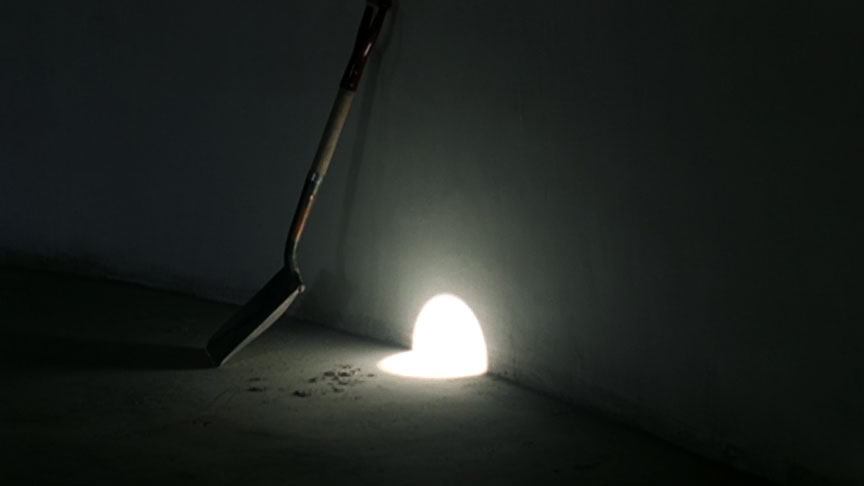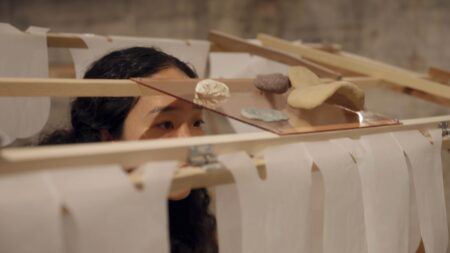Interview
“Roden Crater”

James Turrell at Roden Crater, Arizona, 2000. Production still from the Art in the Twenty-First Century Season 1 episode, Spirituality. © Art21, Inc. 2001.
James Turrell discusses his ongoing land art piece, Roden Crater, created within a pit formed by an extinct volcano in the Arizona desert.
ART21: Where are we, right now?
TURRELL: Well, right now we’re on top of Roden Crater, which is on the western edge of The Painted Desert. And we’re looking at the San Francisco Peaks volcanic field. There are over four hundred craters; this is one of them. And this is the easternmost crater, perhaps tied with South Sheba. So, this is a new crater in this field, but it’s about three hundred eighty thousand years old.
ART21: How did you find this spot?
TURRELL: I flew over the western states, looking for likely spots and opportunities. This was my first choice, and there were two others; one other, I still have the mining lease on. And this has been mined a little bit, also, and was also a motorcycle hill climb. So, it had its uses at the time.
ART21: Could you describe your first sighting of Roden Crater—how you knew this would be the one you wanted to use?
TURRELL: I was coming over the field from the west—actually, about this time of day, about four-thirty in the afternoon—in November. And the sun was just about ready to set, a little bit earlier in the winter. And I saw the craters in this field. There were two that I sort of looked at: one was SP Mountain, that flat one over there, and Antelope Hill, another one on the Babbitt Ranch. And I saw this one. This is really beautiful when the sun hits it in the afternoon, because you really get the red and the black, that separation of the two craters from the west side. And it really stood out. The nice thing about it was that it was off by itself, so it didn’t have other volcanoes that would be in the horizon when you were inside it. So, I landed out here and just walked up into it and stayed overnight here, just went all around it. Then I went in to the county seat (which is Flagstaff) the next day, to see how it was owned. And actually, it was privately held, so I thought, “Oh, I should be able to get this.” That’s another story. (LAUGHS)
ART21: A long story, I imagine.
TURRELL: Anyway, that was how I found it. I spent seven months flying the western states, sleeping under the wing of the plane, and every third night staying in a Holiday Inn, to clean up. And every site that I saw that was interesting generated new work or new ideas. So, it was really a rich time for me.

James Turrell at Roden Crater, Arizona, 2000. Production still from the Art in the Twenty-First Century Season 1 episode, Spirituality. © Art21, Inc. 2001.
ART21: What started you on a quest for this place?
TURRELL: Well, my interest is working with light and space. And you got light and you got space; there’s no doubt of that. And it’s always something to work with light in the outdoors. That’s something that I wanted to do: I wanted to shape space, to use the light that was here naturally. Also, I wanted to use the very fine qualities of light. First of all, moonlight. Also, there’s a space where you can see your shadow from the light of Venus alone—things like this.
And I also wanted to gather starlight that was from outside, light that’s not only from outside the planetary system (which would be from the sun or reflected off of the moon or a planet) but also to emanate light from the galactic planes, where you’ve got this older light that’s away from the light even of our galaxy. So, that is light that would be at least three and a half billion years old. So, you’re gathering light that’s older than our solar system. And it’s possible to gather that light—it takes a good bit of stars to do that—and a good look into older skies, away from the Milky Way. You can gather that light and physically have that in place, so that it’s physically present to feel this old light. Now, that’s a blended light, of course, but it’s also red-shifted, so it’s a different tone of light than we’re normally used to. But that’s something that you can do here, in a place like this, where you have good, dark skies.
So, to have this sort of old blended light and to have this sort of new, eight-and-a-half-minute-old light from the sun—it’s like having the Beaujolais and then having a finer, older mature blend [of wine] as well. And I wanted to look at light that way, because to feel it physically—almost as we taste things—was a quality I wanted. And this is where you can work with light like that.
ART21: Why do you want to work with light?
TURRELL: Certainly, when people describe near-death experiences, they use a vocabulary of light. And also, when we have dreams—a lucid dream that’s in this color—that really is (I think) quite, quite astonishing. So, in thinking of light, if we can think about what it can do and what it is—by thinking about itself, not about what we wanted it to do for other things. Because, again, we’ve used light as people might be used—in the sense that we use it to light paintings. We use it to light so that we can read. We don’t really pay much attention to the light itself.
And so, turning that, and letting light and sound speak for itself, is that you figure out these different relationships and rules. Now, there’s a lot to do with sensory synesthesia as well, in that the feeling of light in so many ways—you probably have seen or handled a lemon and suddenly felt the taste in your mouth; I mean, it suddenly floods your mouth—the perception through vision actually creates the sensation in taste. The same thing can happen in sound, and sound can change the perception of color.
We think of color as a thing that we’re receiving. And if you go into one of the sky spaces, you can see that it’s possible to change the color of the sky. Now, I obviously don’t change the color of the sky, but I changed the context of vision. This is very similar to simultaneous contrast, where you see a yellow dot on a blue field, versus the yellow dot on a red field. Same yellow dot will be seen as two different colors. The same frequencies come into your eyes through a difference of context of vision, and are perceived differently. We actually create this color. Color is this response to what we are perceiving. So, there isn’t something out there that we perceive; we are actually creating this vision—and that we are responsible for it is something we’re rather unaware of.
So, I actually like to do that, and I look at my art as being somewhere between the limits of perception of the creature that we are—that is, what we can actually perceive and not perceive, like the limits of hearing or seeing—and that of learned perception or (we could call) prejudice perception. That’s a situation where we have learned to perceive a certain way, but we’re unaware of the fact that we learned it. So, this can actually work against you, sometimes. Working between those limits and kind of pointing them out is something I enjoy doing. Because it’s not just the fact that you are bringing the cosmos down into the space where you live, but that your perception helps create that as well, so that you really are this co-creator of what you’re seeing.

James Turrell. Roden Crater, Arizona, 2000. Production still from the Art in the Twenty-First Century Season 1 episode, Spirituality, 2001. © Art21, Inc. 2001.
ART21: Can works of art impart a sense of spirituality?
TURRELL: People talk about the spiritual in art, and I think that’s been the territory of artists, all along. You know, if you go into the great cathedrals made by architects and through the light of artisans, you have created a sense of awe that often is greater than what people feel when they read, or any sort of rhetoric by the priesthood. This is something that can be very powerful, in a visual sense. And so, the artists have always been involved in this; this is not something new. And I think that, sometimes, it’s easier for people to approach that portion of the spiritual through the visual than through organized religion, and perhaps that’s true today. But I also want to say that the senses and gratification through the senses, while it can direct you toward the spiritual, is also something that will hold you from it fully. That’s the limit of art. And so, I don’t think that art is terribly spiritual, but it’s something that can be along that way, be a gesture toward that.



